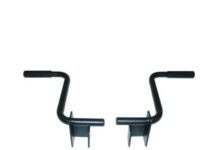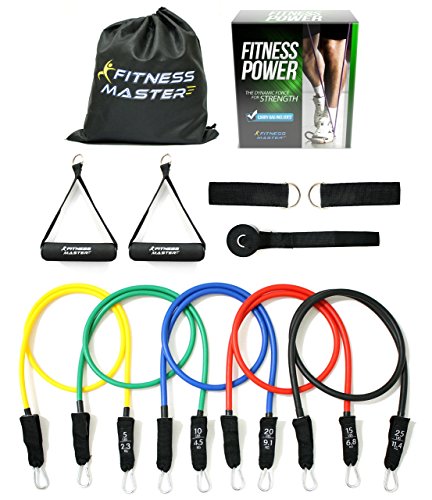Runners, like most athletes, are a particularly dedicated bunch who prioritize getting stronger and staying injury-free. Sure, sometimes they look at me and say, “You want me to do what?” — but they are usually up for anything in our training sessions, especially if it will help safeguard them against injury and allow them to enjoy their sport to their fullest capacity.
A common goal I see among many runners is the desire to improve core strength. Generally runners know they need core training, but they may not always understand why they need it or how best to include it in their programs.
Register for the Women’s Strength and Empowerment Weekend!
Spots are going fast, and it always sells out!
Top 3 Core Training Needs for Runners
At any given time, our muscles are performing one of two roles: moving bones or keeping bones in place. In the context of running, core training addresses three primary needs: pelvic stability, rotational stability, and hip extension. In this article I share what I’ve found to be the best core exercises to enhance a runner’s performance and reduce their susceptibility to injury.
1. Pelvic Stability
Think about your running stride. We talk about putting one foot in front of the other, but what’s really happening is that one leg moves forward while the other moves backwards. The pelvis makes this possible.
The pelvis is a large, bony mass in the middle of your body surrounded from above by your core muscles, and from below by your leg muscles. In order to run efficiently, these muscles need to work in unison. Thinking about the motion of the legs when running, consider what would happen if the leg swinging backwards pulled the pelvis along with it. Because the legs move from the bottom of the pelvis, an unstable pelvis would limit how well the forward leg can move, which would slow you down.
This pelvic instability can also contribute to low back pain for some due to the repetitive tilting of the pelvis with each stride, which can produce a hinging movement in one of the lumbar joints above the pelvis.
To run efficiently, you need to be able to stabilize your pelvis when you move your legs. My go-to exercise for helping runners develop pelvic stability is the dead bug.
Dead Bugs
Most people watch this exercise and think (or sometimes say), “Really? You’re asking me to do that? But it looks so easy!” If you habitually do not stabilize your pelvis when you move your legs, and if you do the exercise properly, this exercise will quickly jump to the top of your own personal “hardest easy-looking exercises” list. There are three levels of dead bugs that I use, starting with a simple hold in the dead bug position, as demonstrated in the video below.
The key to this exercise is maintaining your back position. Often people tell me how easy it is when they initially perform this exercise—until I put my fingers under their low back and have them do it again. Typically they allow their low back to lift off the floor until I cue them to maintain contact. That’s usually when I might hear an expletive followed by a comment about how hard it is. Note that it isn’t necessary to push your low back into the floor; you just need to maintain consistent contact.
Once you can do that version easily, you can progress to moving your limbs while holding the ball in place and maintaining the back position. For the first progression, move one limb at a time, and then progress to moving opposite arm and leg, as shown in the video below:
Single-Leg Lowering
Single-leg lowering is a similar exercise that also promotes pelvic stability. I use two variations of this movement. The first video shows the easier of the two, with one leg against a box (or wall). In the more challenging version, both legs are unsupported and the hands hold onto something (a box, push a wall, pull a band) as a means to help encourage core muscle engagement.
2. Core Stability
Looking at the running stride again, let’s now consider the arms, which are also moving back and forth, in the opposite direction of the legs. (Want to add a little amusement to your next run? Try adding in a few intervals where you force your arms to move in the same direction as your legs. It’s pretty much impossible to do without laughing, or at very least, cracking a smile!)
You may (or may not) be surprised to learn that pumping your arms helps to drive your legs, by transferring energy through the core. Because the arms move counter to the legs, the energy transfer occurs diagonally across the body, or rotationally. The arms move relative to the ribcage in a similar manner to how the legs move relative to the pelvis, so the rib cage essentially behaves as the “pelvis” of the upper body. Because the arms are positioned more laterally in relation to the ribcage than the legs are to the pelvis, the pumping of the arms can cause the rib cage to rotate from side to side. Like the pelvis, the spinal column is the bony attachment to the core, and most of the upper body and core muscles attach to the ribcage.
In order for this arm movement to help you run faster, your core muscles need to keep your ribcage neutral relative to your pelvis, otherwise your body is using that energy to rotate the ribcage instead of to propel you forward. Keeping the ribcage and pelvis from moving away from each other rotationally is called rotational stability.
While this explanation has focused on limiting rotation of the ribcage, some people also need to stabilize the pelvis against rotation. I noted earlier that the arms are at a more lateral position in relation to the rib cage whereas the legs are below the pelvis. In truth, the legs attach at the bottom and sides of the pelvis, although how far to the side varies greatly from person to person. Because the legs attach slightly to the side, there can be an element of rotational movement in the pelvis resulting from the leg movement in the running stride. How much pelvic rotation happens can also depend on the width of your hips. Luckily, most rotary core stability exercises do a good job of training the core to stabilize both the ribcage and the pelvis.
Like with pelvic stability, uncontrolled rotational ribcage and pelvic movement during running may also contribute to low back discomfort, giving runners another reason to spend time developing better rotary stability.
Bird Dogs
The bird dog is another exercise that tends to get labeled as a “hard easy-looking exercise.” It also deserves the “most often done poorly” label, in my opinion. Most people I train have done bird dogs at some point, but when asked to demonstrate, the overwhelming majority of them unknowingly perform it incorrectly.
The key to the bird dog exercise is to stabilize the core, yet most un-coached bird dogs I’ve seen have a lot of core movement. Where most people go wrong is in trying to move their arm and leg as far as they can. By focusing on the limb movement, they almost always rotate or arch their back in the process, failing to stabilize the core. The video below explains this and also provides regressions for anyone having a hard time performing this movement without arching or rotating.
Please don’t take the comments about poor bird dog form personally – I bring it up because I want to make sure it’s clear that the most important thing with this exercise is to have zero movement in the torso. When I coach clients through this movement, I prefer that they lift their arm and/or leg up only one inch and stay steady rather than lift it higher with movement in their back. Steady is the key!
Shoulder Taps
The shoulder tap is a great progression of the bird dog. This exercise starts in the plank position on your hands. Hold it for five seconds, and then lift one hand to tap the opposite shoulder without allowing any movement in the hips. If you’re unable do this without shifting the hips to one side or letting the hips rise, place your feet wider apart until you find a steadier starting position. I typically program five to 12 repetitions per side.
Cable Push+Pull
The cable push+pull is one of my and my clients’ favourite rotary core exercises (quite possibly because it has a ninja feel to it). When performing this exercise, imagine that you’re “punching” the person in front of you while “elbowing” the person behind you. As with other rotary core exercises, the key is to use the core muscles to prevent movement in the torso while moving the arms.
3. Hip Extension
Going back to the running stride, let’s consider the forward and backward leg movements. The technical term when talking about the leg moving backward is extension, and since the leg extends from the hip, it’s called hip extension. The primary muscle group involved in hip extension is the glutes. The hamstrings are also capable of hip extension but they aren’t as good at it as the glutes. The primary role of the hamstring is actually flexing (bending) the knee. Because the hamstrings aren’t as good at hip extension as the glutes, if they are tasked with doing it for too long, they tend to fatigue, at which point they might feel tight.
Any of you runners have hamstrings that always feel tight? Try this test: lie on your back on the ground with your arms on the floor, palms facing up. Keep both knees straight and all toes pointing toward the ceiling and lift one leg up as far as you can. If you can lift it so that it is perpendicular (or very close to perpendicular) with the floor, your tight hamstrings are not related to range of motion or flexibility, which means they feel tight for another reason. One possible reason is that you’re overusing them for hip extension instead of using your glutes for that. In order to help keep the hamstrings happy and make sure the glutes are ready to extend the hips when needed, I make sure that my runners are doing some form of glute strengthening exercise.
There are two exercises I like to use to help strengthen my runners’ glutes, and I introduce them in the following order to ensure that they are capable of doing them properly.
Two-Leg Glute Bridge
I recommend starting with the two-leg glute bridge to ensure that you really are using the glutes and not the hamstrings or low back. Most people will be able to do a two-leg glute bridge. I typically program 10 repetitions of 10-second holds. If you feel it more in your low back than in your glutes, think about moving the entire torso together (rather than pulling up with the low back), and focus on contracting your glutes to raise your hips off the ground, even if that means you don’t lift your hips as high.
Once you can do that and consistently feel the exercise primarily in your glutes (you may also feel some work in the hamstrings and/or quads – that is fine as long as it is primarily glutes), proceed to the next variation, below.
Glute bridge (2 legs, 1 leg, 1 leg)
For this progression, hold the two-leg glute bridge as above for 15 seconds. Then lift one knee toward the ceiling, keeping your hips square. Hold for 15 seconds. Keeping your hips up, put that foot down and lift the other knee for another 15 seconds. Still keeping your hips up, put the other foot down, and repeat the whole process one or two more times.
The best ways to incorporate these exercises into your training program depends on how you’re currently training.
Depending on how you’ve structured your training program, you can perform these exercises during your warm-up before a run or a lifting session, or as active rest between strength training exercises, for example, dead bugs between sets of deadlifts. (If you’re a runner who’s not currently including lower body strength training in your overall program, I strongly urge you to do so. There’s a large body of research showing that strength training can improve your running economy and further reduce injury risk.)
Master these core exercises and you should find that your running improves and your body feels great!
Save $200! Early bird price for the Women’s Strength & Empowerment Weekend ends soon!
The Women’s Strength and Empowerment Weekend, powered by Girls Gone Strong, was designed to create a space for women to rise, teach, lead, learn, and connect with one another. Throughout the weekend you’ll hear from some of the most well-respected women in the world from every facet of the health and wellness industry, from PhDs to Registered Dietitians to top CrossFit athletes, and pre and postnatal fitness and body autonomy experts.

You’ll be surrounded by a group of like-minded, strong women who are there to lift each other up, and help each other become the best version of themselves in a warm, welcoming, and inclusive environment.
You will leave the weekend feeling heard, loved, supported, and empowered and most importantly knowing that you have finally found your tribe.
Last year we sold out in just 26 hours, so if you’re interested in attending, click the button below.
The post 7 Best Core Exercises For Runners appeared first on Girls Gone Strong.






